Rainwater harvesting lets you collect and use rainwater sustainably, giving you an alternative water source for your home. By capturing runoff from roofs, you can greatly reduce your reliance on municipal water, cutting your bills in the process. The system’s key components include gutters, storage tanks, and filtration methods to guarantee clean water. While there are challenges, the benefits range from environmental preservation to enhanced water quality. Curious about the specific techniques and future developments?
Key Takeaways
- Rainwater harvesting captures runoff from roofs using gutters, downspouts, and storage solutions like barrels and cisterns for sustainable water supply.
- The system reduces dependence on municipal water, lowering bills and easing strain on local resources while promoting self-sufficiency.
- Proper filtration and treatment methods ensure collected rainwater is safe for irrigation and other non-potable uses, enhancing water quality.
- Regular maintenance and effective installation are crucial for system efficiency, preventing issues like clogging and contamination.
- Community education and engagement can drive acceptance and adoption of rainwater harvesting as a sustainable practice for local water management.
Understanding Rainwater Harvesting Techniques
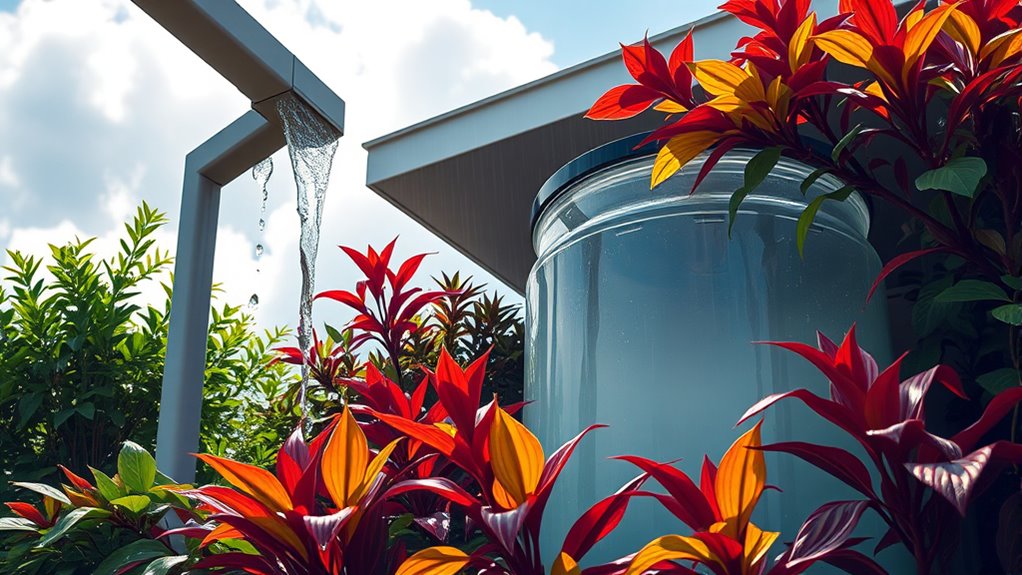
When you consider rainwater harvesting, you’ll find it involves various techniques designed to collect and store rain for practical uses.
One popular method is surface runoff, where you collect rainwater from rooftops using gutters and downspouts, directing it into rain barrels for easy storage. This approach is cost-effective and simple to install. Additionally, this method contributes to the reduction of stormwater runoff, minimizing flooding and groundwater pollution in your area. Implementing such systems can also help mitigate the impact of deforestation on local ecosystems by reducing the demand for municipal water sources. Moreover, utilizing predictive analytics can enhance the efficiency of rainwater harvesting systems by optimizing collection and storage based on weather patterns. Furthermore, rainwater harvesting can complement solar energy solutions by providing alternative water sources for irrigation in solar-powered agricultural systems.
A cost-effective and simple method, surface runoff collects rainwater from rooftops into storage barrels.
On the other hand, groundwater recharge techniques capture rainwater to replenish underground supplies through borewells or tubewells, but these systems tend to be more complex and costly.
Both techniques promote sustainability by reducing your reliance on municipal water, conserving resources, and supporting eco-friendly living.
Understanding these methods helps you make informed choices about how to utilize rainwater effectively.
Key Components of Rainwater Harvesting Systems
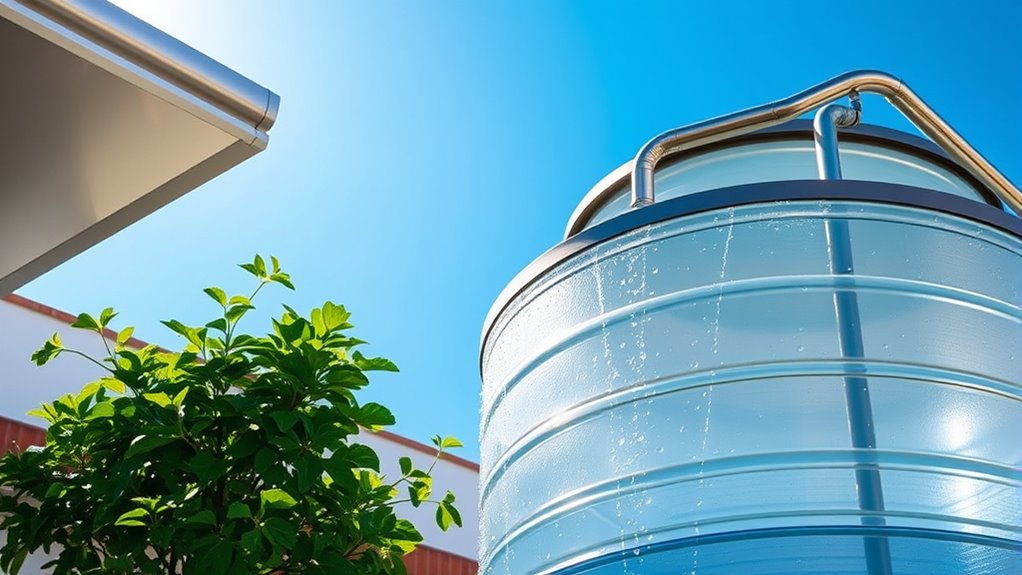
To effectively harvest rainwater, you need to understand the key components that make up a successful system.
Start with catchment surfaces, like roofs made of reinforced cement, galvanized iron, or even paved areas. Portable camping toilets are also a great addition to outdoor setups, ensuring sanitary conditions while collecting rainwater. Proper filtration systems are essential to enhance the quality of the harvested water, as they help remove contaminants and improve usability.
Next, use conveyance systems, including gutters and downspouts, to direct water into storage. Integrated systems like roofs often come with built-in conveyance systems to enhance water collection.
Don’t forget filtration and treatment methods, such as first flush diverters and sand filters, to guarantee clean water.
For storing rainwater, consider options like rain barrels, cisterns, or steel tanks, which can be optimized for backyard greenhouses to ensure a sustainable water supply for plants.
Finally, include distribution systems with outlet pipes and pumps, as well as overflow solutions like rain gardens.
Benefits of Collecting Rainwater
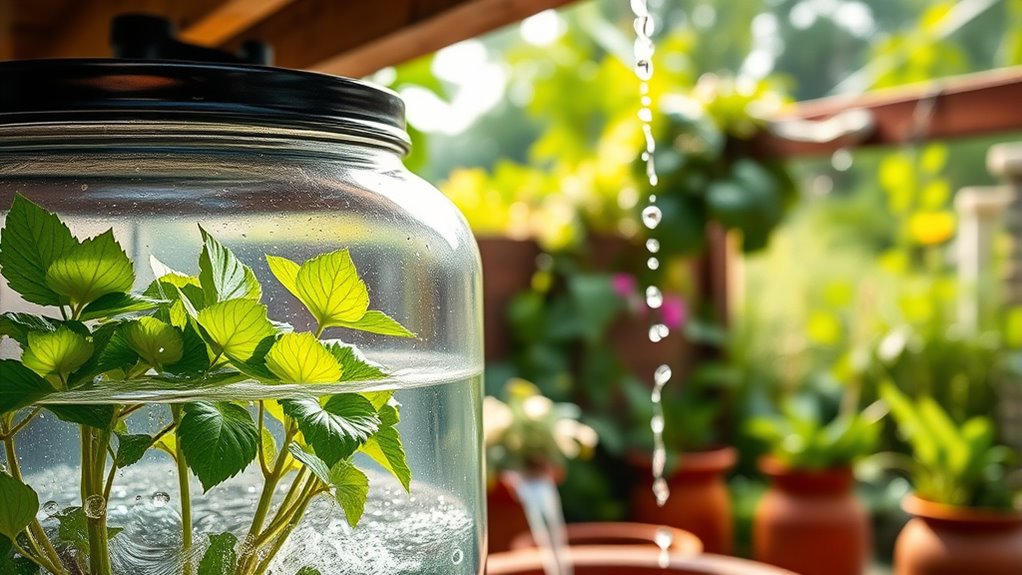
Collecting rainwater offers a range of benefits that can greatly enhance your water management practices.
By reducing your dependence on municipal water supplies, you’ll lower your water bills and achieve long-term savings. It also eases the strain on local water systems, potentially decreasing municipal taxes. You’ll promote self-sufficiency and foster a sense of independence in your water usage. Additionally, reducing demand on groundwater supports long-term water conservation efforts, ensuring that vital resources remain available for future generations. Implementing rainwater harvesting practices can also help improve home energy efficiency, as it reduces the need for energy-intensive water transportation and treatment. Furthermore, using rainwater capture techniques can maximize your collection efficiency and enhance the overall effectiveness of your system.
Moreover, organized environments can contribute to a more efficient and sustainable approach to managing your harvested water resources. Rainwater is chemical-free, ideal for nourishing plants while supporting healthier soil. This practice encourages water conservation awareness, preserving essential groundwater resources.
During droughts or emergencies, it provides a reliable alternative water source, ensuring you’re prepared. Plus, implementing rainwater harvesting can even boost your property value by showcasing environmentally friendly practices.
Sustainability and Environmental Impact
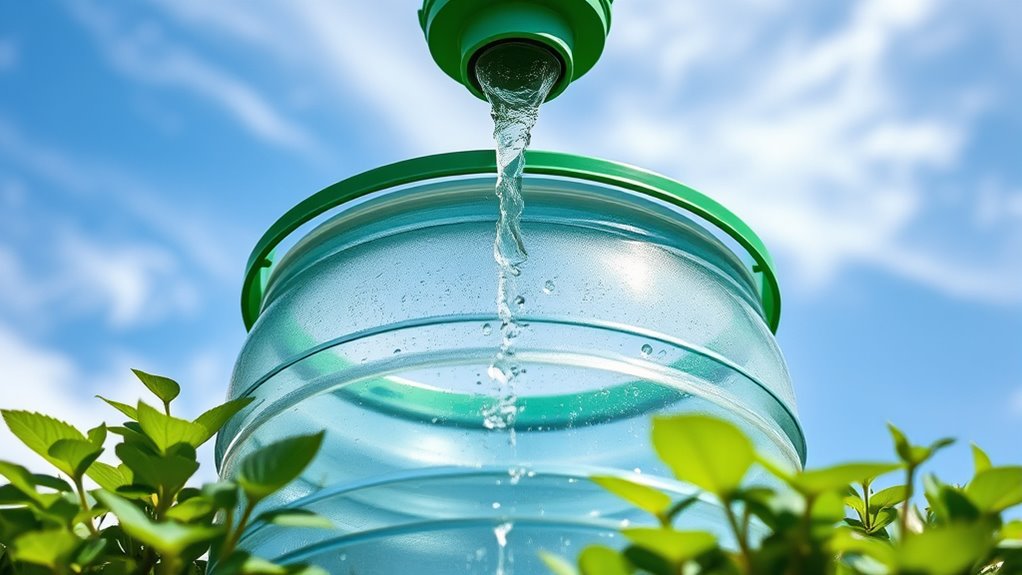
Rainwater harvesting stands as a powerful tool for promoting sustainability and minimizing environmental impact. By collecting rainwater, you reduce the demand on municipal water supplies, conserving essential natural resources. This practice enhances water quality and supports local ecosystems, helping to maintain biodiversity. You’ll also lower your carbon footprint by decreasing reliance on energy-intensive water sources, as harvesting rainwater conserves energy used in the treatment process. Moreover, it plays a crucial role in groundwater recharge, improving the availability of water for both human and ecological needs. The systems are cost-effective and easy to maintain, providing high-quality water for various uses, including frozen yogurt production in local shops. Additionally, implementing integrated pest management strategies can help maintain garden health while utilizing harvested water. Capturing rainwater minimizes stormwater runoff, which protects local waterways and wildlife habitats. As you engage in rainwater harvesting, you contribute to groundwater recharge, healthier soil, and erosion prevention, making your garden more resilient while supporting a sustainable future.
Challenges and Limitations of Rainwater Harvesting
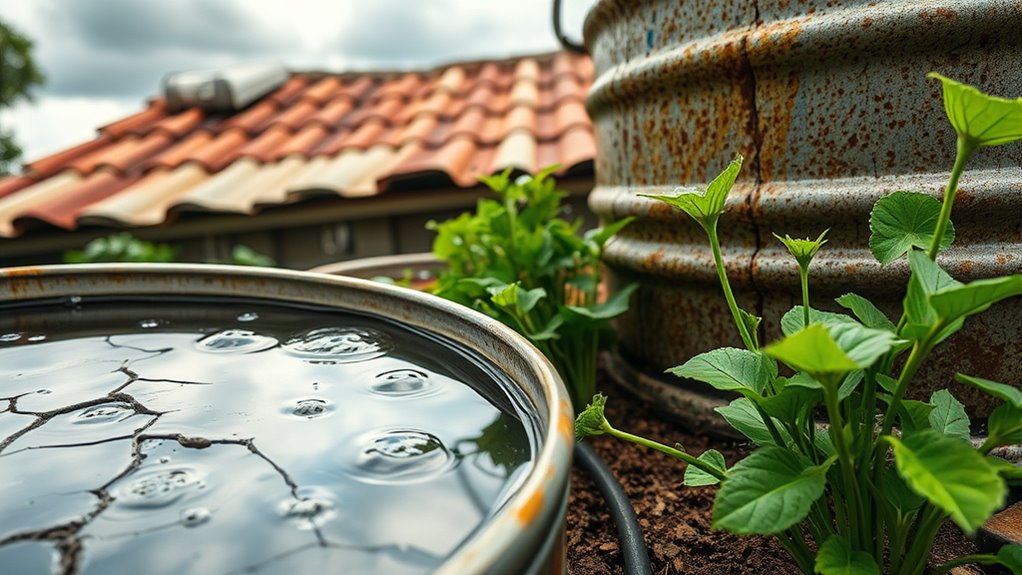
While rainwater harvesting offers numerous benefits for sustainability and environmental impact, it also comes with a set of challenges and limitations that can hinder its effectiveness.
Unpredictable rainfall can affect your system’s reliability, while high initial costs may deter you from installing one. Storage limitations can restrict how much water you collect, and regular maintenance is essential to keep the system running efficiently. Additionally, proper installation is crucial to avoid problems such as mosquito breeding and diseases. Inadequate maintenance can lead to decreased efficiency and premature breakdown of the system. The need for color accuracy in harvesting systems can also impact the overall effectiveness of water collection methods. It is important to also consider the role of support systems in encouraging community engagement and education about rainwater harvesting.
You also need to take into account water quality concerns, as harvested rainwater may not always meet drinking standards. Additionally, space constraints, technical skills for installation, and issues like clogging or animal infestation can pose significant challenges.
Finally, cultural perceptions and community engagement can influence the overall acceptance of rainwater harvesting in your area.
Future Developments and Integration of Rainwater Harvesting Systems
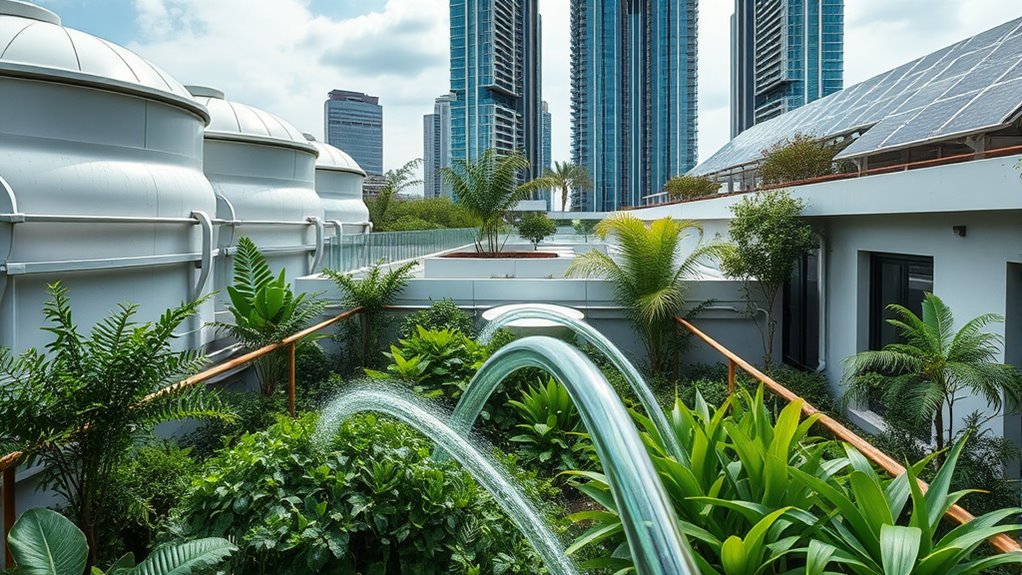
As the demand for sustainable water solutions increases, the future of rainwater harvesting systems looks promising. You can expect greater adoption fueled by environmental awareness and government incentives. Increased adoption is expected to be further supported by initiatives such as tax credits and rebates for eligible users.
Smart technology will revolutionize these systems, using sensors and real-time data to optimize collection and distribution. This shift towards modern farmhouse design principles emphasizes practical solutions that enhance functionality and aesthetics. Eco-friendly materials, like steel tanks, are gaining traction for their recyclability.
Commercial applications are expanding, enhancing irrigation and industrial processes. Additionally, integrating rainwater harvesting with greywater reuse and water-saving fixtures boosts efficiency.
Decentralized management and predictive analytics will give you more localized control over water resources. With the market projected to reach $2.7 billion by 2029, rainwater harvesting is set to play a vital role in sustainable water management.
Frequently Asked Questions
How Much Rainwater Can a Typical Household Collect Annually?
You can typically collect between 600 to 1,200 gallons of rainwater annually from a standard household roof, depending on your location’s rainfall and roof size.
For example, a 1,000 square foot roof in an area with 30 inches of rain could yield about 18,750 gallons, but collection efficiency and storage capacity will impact what you actually gather.
Don’t forget to factor in local regulations that might affect your collection efforts!
What Types of Roofs Are Best for Rainwater Harvesting?
When you’re selecting a roof for rainwater harvesting, metal roofing tops the list due to its durability and high runoff efficiency.
Slate and tile roofs also work well, offering longevity with minimal maintenance.
While asphalt shingles are cost-effective, they can contaminate water over time.
Avoid wooden, treated, asbestos, or lead-coated roofs, as they pose health risks.
Prioritize materials that guarantee water quality and maximize collection efficiency for the best results.
Can Rainwater Be Treated for Drinking Purposes?
Yes, you can treat rainwater for drinking purposes, but it requires proper methods.
First, you’ll need to filter out debris and then disinfect it to eliminate harmful microorganisms.
Advanced techniques like reverse osmosis or UV sterilization can guarantee the water’s safe for consumption.
Regular testing is essential to maintain quality.
How Often Should Rainwater Harvesting Systems Be Maintained?
You should maintain your rainwater harvesting system at least twice a year.
Regular inspections help catch issues early, especially after heavy storms. Check components like inlets and tanks for blockages or damage.
Clean gutters frequently to guarantee water quality, and inspect your roof annually.
Additionally, clean storage tanks every 6 to 12 months to prevent algae buildup.
Following these guidelines keeps your system efficient and prolongs its lifespan.
Are There Legal Regulations Governing Rainwater Harvesting?
Yes, there are legal regulations governing rainwater harvesting, but they vary considerably by state and locality.
You’ll find that some states encourage it, while others impose strict limitations or require permits.
For instance, in Colorado, you can only collect a limited amount without registration.
Make certain to check your local laws and regulations to guarantee your rainwater collection system complies, as municipal rules may also apply.
Conclusion
To sum up, embracing rainwater harvesting isn’t just a choice; it’s a revolution in sustainability! By collecting and using rainwater, you’re not only slashing your water bills but also turning your home into an eco-friendly fortress. Imagine transforming every drop of rain into a life-giving resource, all while saving the planet! As technology advances, your rainwater system could become the crown jewel of your environmental legacy, ensuring a greener future for generations to come.









